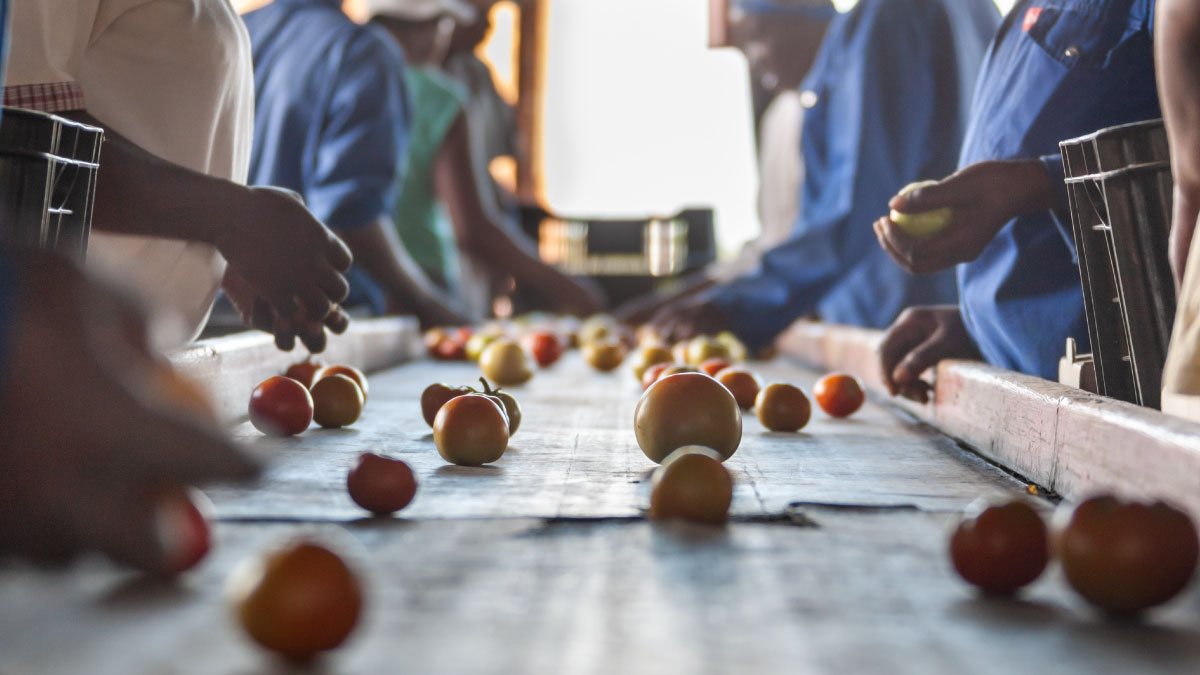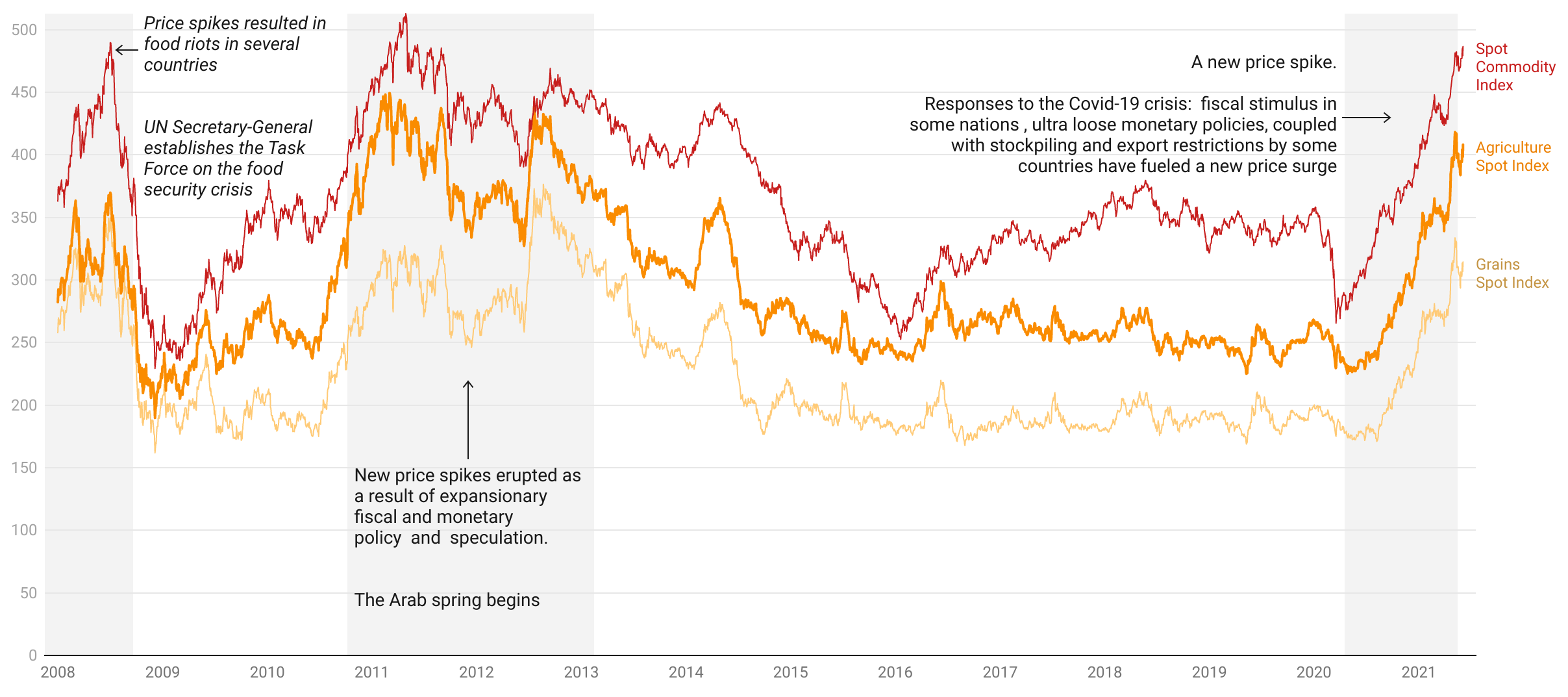By David Bicchetti, Carlos Razo and Miho Shirotori
© poco_bw
Access to food should never be a luxury. It is a fundamental human right. Yet in 2020, 155 million people faced severe food insecurity. And the situation could deteriorate further. Food prices are perilously climbing to heights like those that have sparked food crises and riots in many parts of the world during the last two decades.
Making sure this situation does not worsen – and in fact improves – depends on many factors. One has to do with the capacity of a country to produce food at home and import it from abroad. This is where trade comes in, and its role is not minor. The value of food imports has tripled since the beginning of the century, and today about 80% of the world’s population is fed in part by imports.
Chart: World commodity and food prices dynamics, January 2008 - June 2021
Source: Authors' calculations based on data from Thomson Reuters (Bloomberg Commodity Index)
Exports at the expense of staple foods
The expansion of global trade has helped to, at least in part, move food from where it can be produced to where it is needed. But this has also come with downsides. Many developing countries have increased their specialization in export crops at the expense of staple foods for domestic consumption, making them net food importers with the vulnerabilities this implies.
In Africa, a continent with severe food insecurity challenges, most food comes from abroad. Between 2016-2018 about 85% of food was imported from outside the continent. And as its population grows, net food imports to Africa are expected to triple by 2025 even as undernourishment grows by one-third.
In the Caribbean, food imports as a proportion of merchandise exports skyrocketed from 5% in 1995 to 32% in 2019. And overall, only four out of 12 developing regions show a positive net balance in basic food trade.
Trade dependence for basic food
Ratio of basic food balance to total merchandise exports
Source: Authors' calculations based on UNCTAD statistics
This excessive exposure to global markets, and reliance on foreign supply, increases risks and price volatility, which in turn compromises food security in many countries, with the stark human consequences it entails. The trade community cannot be oblivious to this and must act fast – and there is a way.
A fair agriculture trading system
In 1995 an agreement on agriculture was reached under World Trade Organization (WTO). It aimed at establishing “a fair and market-oriented agricultural trading system” under the multilateral trade rules and disciplines (the preamble of the WTO Agreement on Agriculture).
While the agreement was a major multilateral achievement, the incomplete implementation of it and the lack of use of provisions for special and differential treatment have limited the ability of some developing countries to deal with food security concerns.
It is true that the agreement embeds an asymmetric use of trade-distorting subsides. The amount of trade-distorting support allowed by a country was determined based on the 1986-1988 levels, when 95% of subsides came from developed countries. This gives a higher baseline to richer nations.
Nevertheless, developing countries are allowed a higher de minimis of domestic support (10%) than developed countries (5%). The de minimis clause allows WTO members not to include possible trade-distorting domestic support measures in their reduction commitment if the value of such support does not exceed 5% of the member’s total value of production during the relevant year.
In addition, developing countries can use investment and agricultural inputs subsidies to low-income producers. They can also rely on public stockholding, domestic aid for goods and income insurance programmes.
Many of these provisions, or opportunities to increase domestic food production, have not been used for two main reasons. First, because some of the clauses in the agreement were considered not strictly enforceable. Second, most developing countries lack the fiscal capacity to effectively use such provisions.
The need for global cooperation
Conflict and war, weather extremes and economic shocks, including those induced by COVID-19, are primary drivers of insecurity. Trade policy will not be enough to cover such a wide front, but it can help to improve food security. And it needs to do so urgently.
This requires cooperation and a firm commitment from WTO members to finally remove the limitations and asymmetries of the agreement on agriculture.
This implies the following:
- Banning export restrictions on essential foodstuffs for food deficit countries, and on food aid to countries in emergency situations
- Enhancing the support to resource poor agricultural producers by modifying article 6.2 and updating the de minimis limit and facilitate support to vulnerable producers, including women
- Finding a permanent solution to public stockholding for food security purposes, an issue that has been pending at the WTO since 2013
- Increase financial and technical support to foster agricultural productivity in developing countries in order to address food security, especially in least developed countries and net-food importing developing countries
Delaying the implementation of measures to increase food production in food insecure countries goes beyond delaying an agreement. It denies millions of people of a fundamental human right.
An empty negotiation table in Geneva means empty dinner tables around the world, with millions of men, women and children living with the agonizing feeling of an empty stomach. This is why we cannot wait. 2021 must be the year when the right to food is finally embedded in the global trade architecture. The upcoming ministerial conferences of the WTO (MC12) and UNCTAD (UNCTAD15) are opportunities the global community simply cannot miss.
Miho Shirotori heads UNCTAD's trade negotiations and commercial diplomacy branch. Carlos Razo and David Bicchetti are economists working in UNCTAD's international trade and commodities division.
Development in motion
In a series of dynamic graphs, we explain some of the salient issues facing the global economy today.


